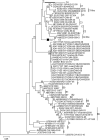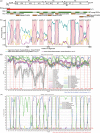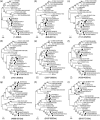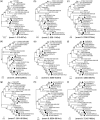A novel subgenotype C6 Enterovirus A71 originating from the recombination between subgenotypes C4 and C2 strains in mainland China
- PMID: 35022489
- PMCID: PMC8755819
- DOI: 10.1038/s41598-021-04604-x
A novel subgenotype C6 Enterovirus A71 originating from the recombination between subgenotypes C4 and C2 strains in mainland China
Abstract
Recombination plays important roles in the genetic diversity and evolution of Enterovirus A71 (EV-A71). The phylogenetics of EV-A71 in mainland China found that one strain DL71 formed a new subgenotype C6 with unknown origin. This study investigated the detailed genetic characteristics of the new variant. DL71 formed a distinct cluster within genotype C based on the genome and individual genes (5'UTR, VP4, VP1, 2A, 2B, 2C, 3D, and 3'UTR). The average genetic distances of the genome and individual genes (VP3, 2A, 2B, 2C, 3A, 3C, and 3D) between DL71 and reference strains were greater than 0.1. Nine recombination events involving smaller fragments along DL71 genome were detected. The strains Fuyang-0805a (C4) and Tainan/5746/98 (C2) were identified as the parental strains of DL71. In the non-recombination regions, DL71 had higher identities with Fuyang-0805a than Tainan/5746/98, and located in the cluster with C4 strains. However, in the recombination regions, DL71 had higher identities with Tainan/5746/98 than Fuyang-0805a, and located in the cluster with C2 strains. Thus, DL71 was a novel multiple inter-subgenotype recombinant derived from the dominant subgenotype C4 and the sporadic subgenotype C2 strains. Monitoring the emergence of new variants by the whole-genome sequencing remains essential for preventing disease outbreaks and developing new vaccines.
© 2022. The Author(s).
Conflict of interest statement
The authors declare no competing interests.
Figures






Similar articles
-
Molecular epidemiology and recombination of Enterovirus A71 in mainland China from 1987 to 2017.Int Microbiol. 2021 Aug;24(3):291-299. doi: 10.1007/s10123-021-00164-2. Epub 2021 Feb 19. Int Microbiol. 2021. PMID: 33608776 Free PMC article.
-
Isolation of an imported subgenotype B5 strain of human enterovirus A71 in Chongqing City, China, 2014.Virol J. 2016 Jun 29;13:115. doi: 10.1186/s12985-016-0571-x. Virol J. 2016. PMID: 27357279 Free PMC article.
-
Discovery of Enterovirus A71-like nonstructural genomes in recent circulating viruses of the Enterovirus A species.Emerg Microbes Infect. 2018 Jun 21;7(1):111. doi: 10.1038/s41426-018-0107-0. Emerg Microbes Infect. 2018. PMID: 29930332 Free PMC article.
-
Viral determinants that drive Enterovirus-A71 fitness and virulence.Emerg Microbes Infect. 2021 Dec;10(1):713-724. doi: 10.1080/22221751.2021.1906754. Emerg Microbes Infect. 2021. PMID: 33745413 Free PMC article. Review.
-
Changes in the EV-A71 Genome through Recombination and Spontaneous Mutations: Impact on Virulence.Viruses. 2018 Jun 12;10(6):320. doi: 10.3390/v10060320. Viruses. 2018. PMID: 29895721 Free PMC article. Review.
Cited by
-
Molecular evolutionary dynamics of enterovirus A71, coxsackievirus A16 and coxsackievirus A6 causing hand, foot and mouth disease in Thailand, 2000-2022.Sci Rep. 2023 Oct 13;13(1):17359. doi: 10.1038/s41598-023-44644-z. Sci Rep. 2023. PMID: 37833525 Free PMC article.
-
First detection and molecular characteristics of bopivirus from goats in China.Front Vet Sci. 2022 Dec 1;9:1033011. doi: 10.3389/fvets.2022.1033011. eCollection 2022. Front Vet Sci. 2022. PMID: 36532341 Free PMC article.
-
Diversity of Human Enterovirus Co-Circulations in Five Kindergartens in Bangkok between July 2019 and January 2020.Viruses. 2023 Jun 20;15(6):1397. doi: 10.3390/v15061397. Viruses. 2023. PMID: 37376696 Free PMC article.
-
Phylogeographic dynamics and molecular characteristics of Enterovirus 71 in China.Front Microbiol. 2023 May 19;14:1182382. doi: 10.3389/fmicb.2023.1182382. eCollection 2023. Front Microbiol. 2023. PMID: 37275165 Free PMC article.
-
Enteroviruses: epidemic potential, challenges and opportunities with vaccines.J Biomed Sci. 2024 Jul 15;31(1):73. doi: 10.1186/s12929-024-01058-x. J Biomed Sci. 2024. PMID: 39010093 Free PMC article. Review.
References
-
- Chen X, et al. Analysis of recombination and natural selection in human enterovirus 71. Virology. 2010;398:251–261. - PubMed
Publication types
MeSH terms
Substances
Grants and funding
- BK20180269/Natural Science Foundation of Jiangsu Province
- QN160204/Youth Talents Hansoh Foundation of the First People's Hospital of Lianyungang
- QN160103/Youth Talents Hansoh Foundation of the First People's Hospital of Lianyungang
- 2018CFB254/Natural Science Foundation of Hubei Province
- EX20D04/Wuhan COVID-19 Emergency Research Project of Hubei Province
LinkOut - more resources
Full Text Sources
Miscellaneous

